Business Case Analysis: Challenges and Solutions for Virtual Teams
VerifiedAdded on 2020/02/23
|9
|1680
|145
Case Study
AI Summary
This case study examines the challenges faced by a virtual team in an Executive MBA program. The analysis highlights issues such as technological incompatibilities, communication difficulties, and the need for effective project management. The case explores solutions like synchronous meetings, asynchronous document sharing through platforms like Dropbox and Google Drive, and the use of project management tools such as Basecamp and Microsoft Project. The study also discusses the importance of team-based activities in educational programs, emphasizing how they boost individual confidence and prepare students for classroom experiences. The conclusion underscores the significance of addressing communication challenges and building trust within virtual teams to achieve cohesive and successful outcomes. The report includes references to support the findings and recommendations.

Running head: BUSINESS CASE ANALYSIS
BUSINESS CASE ANALYSIS
Name of Student
Name of University
Author Name
BUSINESS CASE ANALYSIS
Name of Student
Name of University
Author Name
Paraphrase This Document
Need a fresh take? Get an instant paraphrase of this document with our AI Paraphraser

1BUSINESS CASE ANALYSIS
To:Director EMBA
From:
Date:
Subject: Business Case Analysis
To:Director EMBA
From:
Date:
Subject: Business Case Analysis
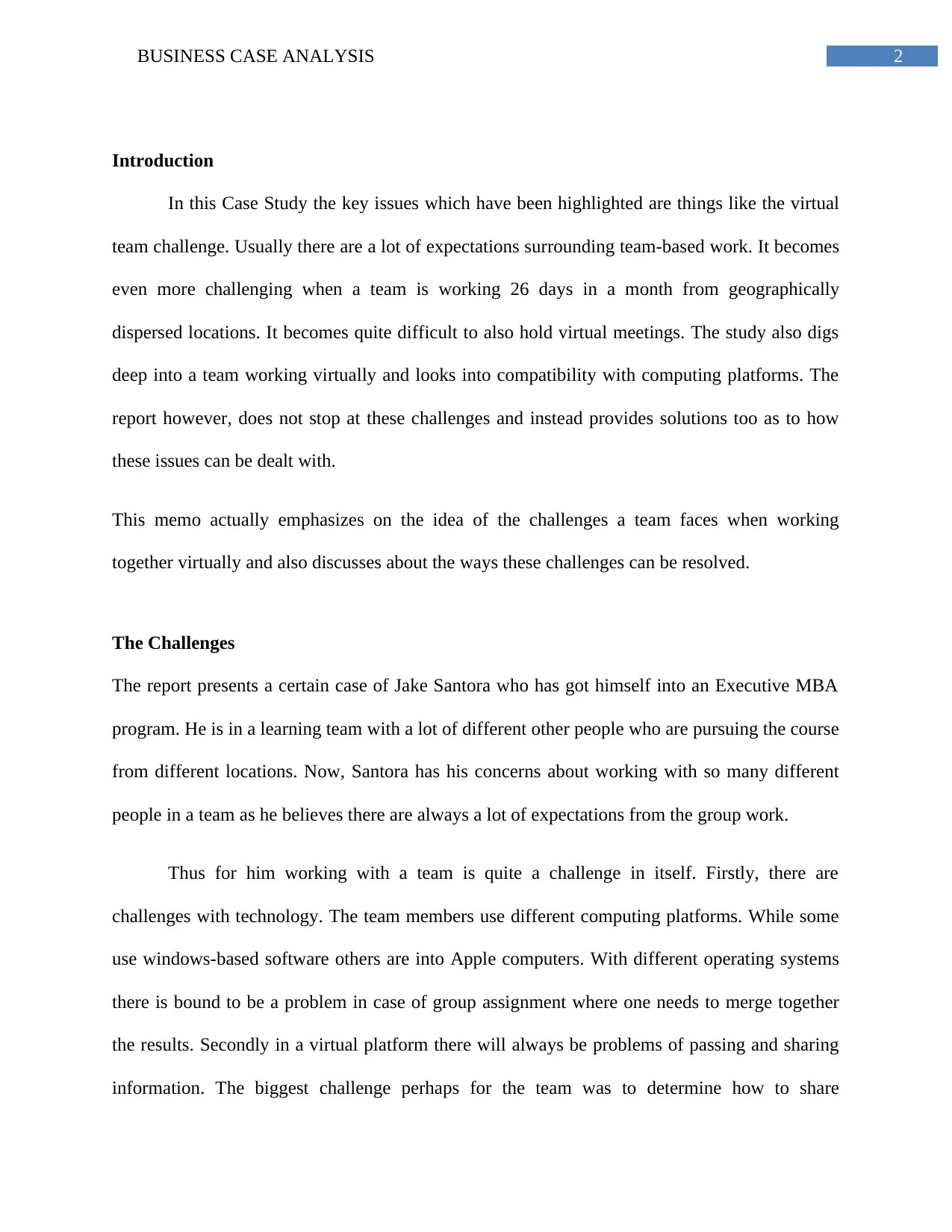
2BUSINESS CASE ANALYSIS
Introduction
In this Case Study the key issues which have been highlighted are things like the virtual
team challenge. Usually there are a lot of expectations surrounding team-based work. It becomes
even more challenging when a team is working 26 days in a month from geographically
dispersed locations. It becomes quite difficult to also hold virtual meetings. The study also digs
deep into a team working virtually and looks into compatibility with computing platforms. The
report however, does not stop at these challenges and instead provides solutions too as to how
these issues can be dealt with.
This memo actually emphasizes on the idea of the challenges a team faces when working
together virtually and also discusses about the ways these challenges can be resolved.
The Challenges
The report presents a certain case of Jake Santora who has got himself into an Executive MBA
program. He is in a learning team with a lot of different other people who are pursuing the course
from different locations. Now, Santora has his concerns about working with so many different
people in a team as he believes there are always a lot of expectations from the group work.
Thus for him working with a team is quite a challenge in itself. Firstly, there are
challenges with technology. The team members use different computing platforms. While some
use windows-based software others are into Apple computers. With different operating systems
there is bound to be a problem in case of group assignment where one needs to merge together
the results. Secondly in a virtual platform there will always be problems of passing and sharing
information. The biggest challenge perhaps for the team was to determine how to share
Introduction
In this Case Study the key issues which have been highlighted are things like the virtual
team challenge. Usually there are a lot of expectations surrounding team-based work. It becomes
even more challenging when a team is working 26 days in a month from geographically
dispersed locations. It becomes quite difficult to also hold virtual meetings. The study also digs
deep into a team working virtually and looks into compatibility with computing platforms. The
report however, does not stop at these challenges and instead provides solutions too as to how
these issues can be dealt with.
This memo actually emphasizes on the idea of the challenges a team faces when working
together virtually and also discusses about the ways these challenges can be resolved.
The Challenges
The report presents a certain case of Jake Santora who has got himself into an Executive MBA
program. He is in a learning team with a lot of different other people who are pursuing the course
from different locations. Now, Santora has his concerns about working with so many different
people in a team as he believes there are always a lot of expectations from the group work.
Thus for him working with a team is quite a challenge in itself. Firstly, there are
challenges with technology. The team members use different computing platforms. While some
use windows-based software others are into Apple computers. With different operating systems
there is bound to be a problem in case of group assignment where one needs to merge together
the results. Secondly in a virtual platform there will always be problems of passing and sharing
information. The biggest challenge perhaps for the team was to determine how to share
⊘ This is a preview!⊘
Do you want full access?
Subscribe today to unlock all pages.

Trusted by 1+ million students worldwide
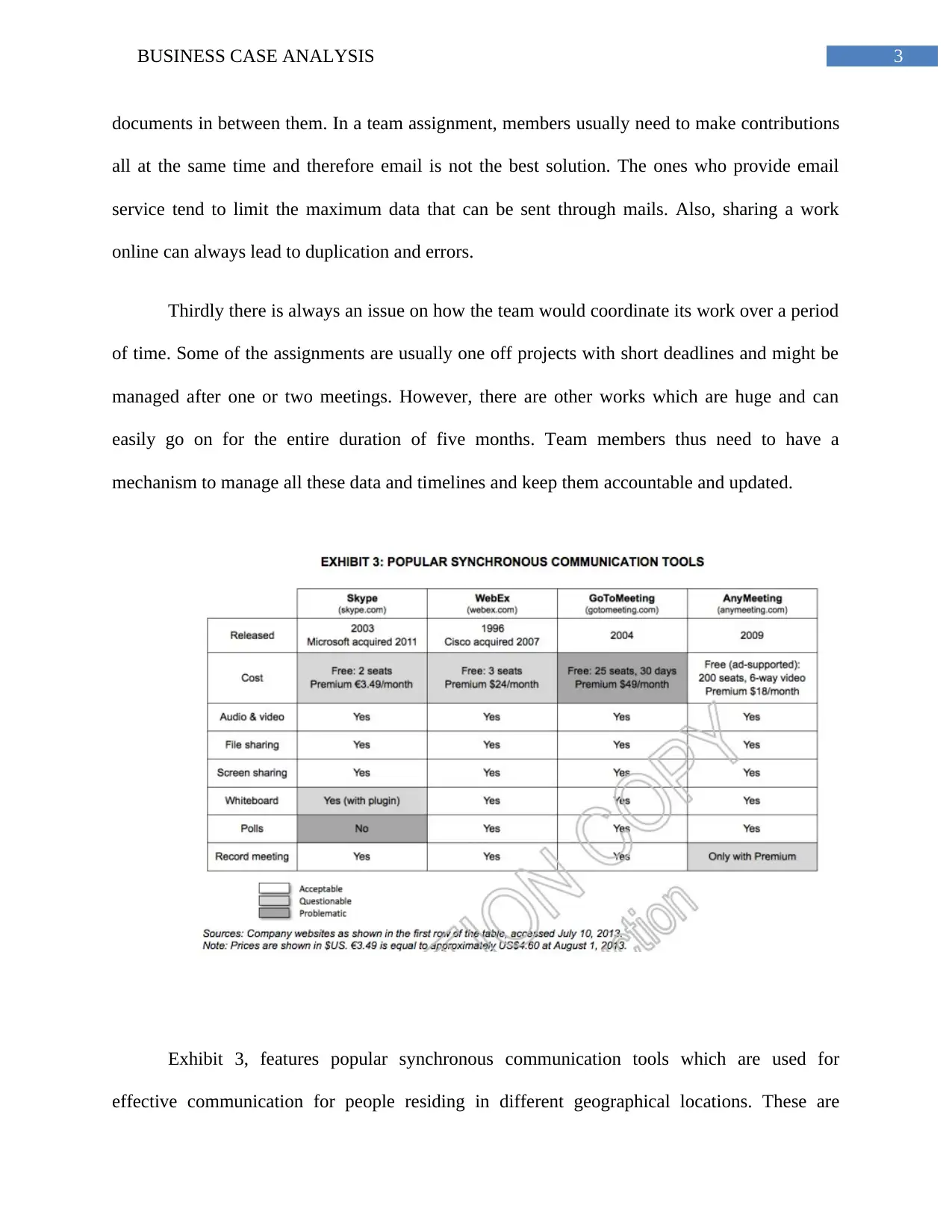
3BUSINESS CASE ANALYSIS
documents in between them. In a team assignment, members usually need to make contributions
all at the same time and therefore email is not the best solution. The ones who provide email
service tend to limit the maximum data that can be sent through mails. Also, sharing a work
online can always lead to duplication and errors.
Thirdly there is always an issue on how the team would coordinate its work over a period
of time. Some of the assignments are usually one off projects with short deadlines and might be
managed after one or two meetings. However, there are other works which are huge and can
easily go on for the entire duration of five months. Team members thus need to have a
mechanism to manage all these data and timelines and keep them accountable and updated.
Exhibit 3, features popular synchronous communication tools which are used for
effective communication for people residing in different geographical locations. These are
documents in between them. In a team assignment, members usually need to make contributions
all at the same time and therefore email is not the best solution. The ones who provide email
service tend to limit the maximum data that can be sent through mails. Also, sharing a work
online can always lead to duplication and errors.
Thirdly there is always an issue on how the team would coordinate its work over a period
of time. Some of the assignments are usually one off projects with short deadlines and might be
managed after one or two meetings. However, there are other works which are huge and can
easily go on for the entire duration of five months. Team members thus need to have a
mechanism to manage all these data and timelines and keep them accountable and updated.
Exhibit 3, features popular synchronous communication tools which are used for
effective communication for people residing in different geographical locations. These are
Paraphrase This Document
Need a fresh take? Get an instant paraphrase of this document with our AI Paraphraser
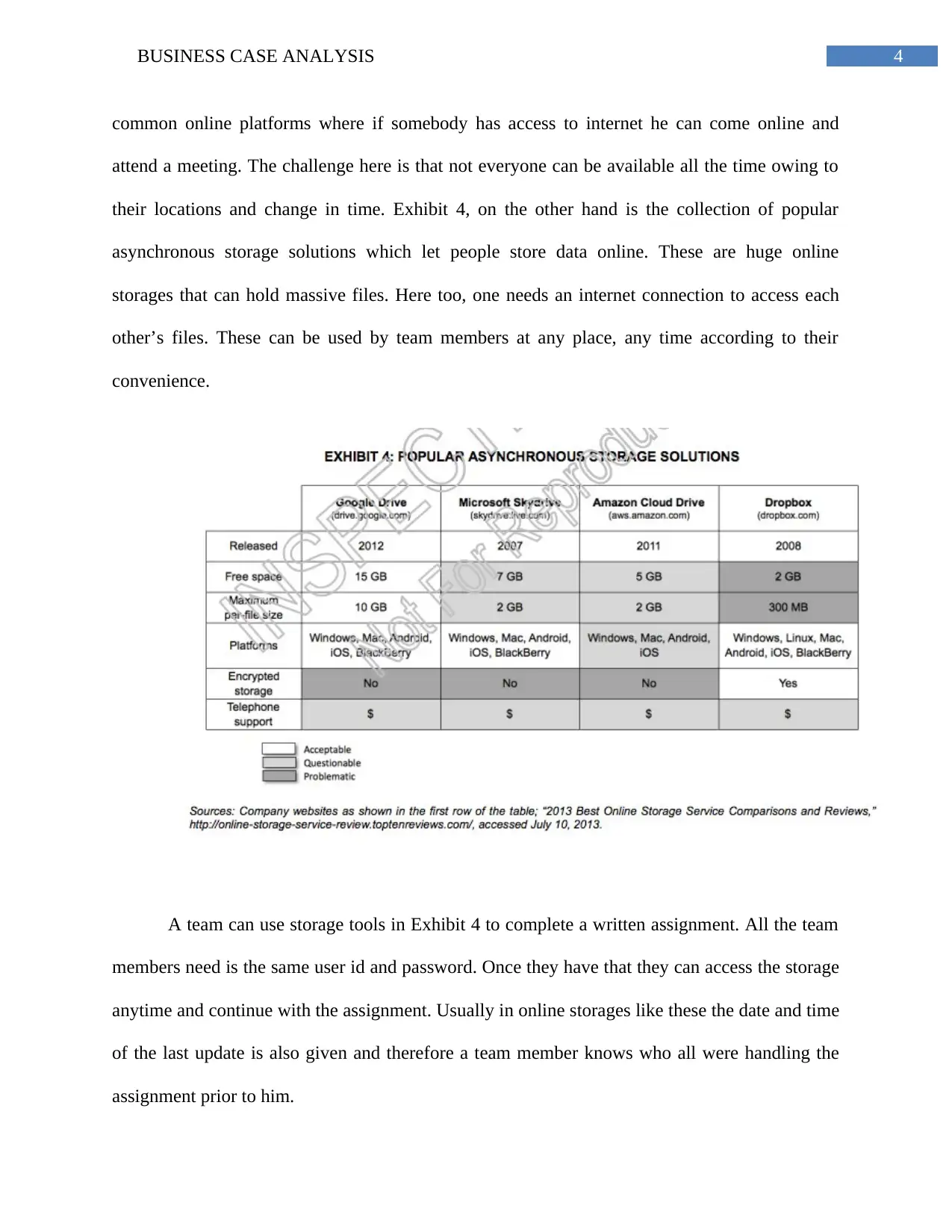
4BUSINESS CASE ANALYSIS
common online platforms where if somebody has access to internet he can come online and
attend a meeting. The challenge here is that not everyone can be available all the time owing to
their locations and change in time. Exhibit 4, on the other hand is the collection of popular
asynchronous storage solutions which let people store data online. These are huge online
storages that can hold massive files. Here too, one needs an internet connection to access each
other’s files. These can be used by team members at any place, any time according to their
convenience.
A team can use storage tools in Exhibit 4 to complete a written assignment. All the team
members need is the same user id and password. Once they have that they can access the storage
anytime and continue with the assignment. Usually in online storages like these the date and time
of the last update is also given and therefore a team member knows who all were handling the
assignment prior to him.
common online platforms where if somebody has access to internet he can come online and
attend a meeting. The challenge here is that not everyone can be available all the time owing to
their locations and change in time. Exhibit 4, on the other hand is the collection of popular
asynchronous storage solutions which let people store data online. These are huge online
storages that can hold massive files. Here too, one needs an internet connection to access each
other’s files. These can be used by team members at any place, any time according to their
convenience.
A team can use storage tools in Exhibit 4 to complete a written assignment. All the team
members need is the same user id and password. Once they have that they can access the storage
anytime and continue with the assignment. Usually in online storages like these the date and time
of the last update is also given and therefore a team member knows who all were handling the
assignment prior to him.
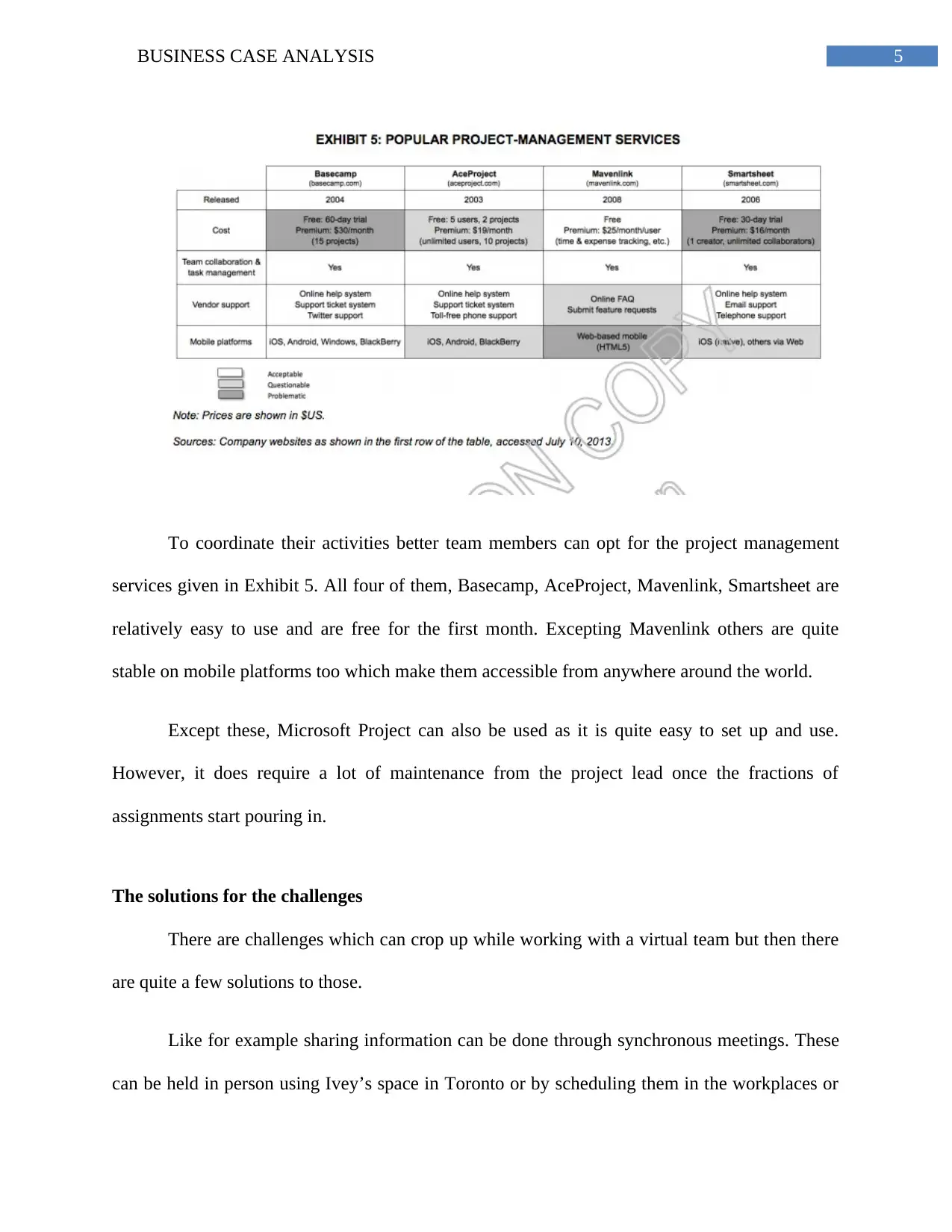
5BUSINESS CASE ANALYSIS
To coordinate their activities better team members can opt for the project management
services given in Exhibit 5. All four of them, Basecamp, AceProject, Mavenlink, Smartsheet are
relatively easy to use and are free for the first month. Excepting Mavenlink others are quite
stable on mobile platforms too which make them accessible from anywhere around the world.
Except these, Microsoft Project can also be used as it is quite easy to set up and use.
However, it does require a lot of maintenance from the project lead once the fractions of
assignments start pouring in.
The solutions for the challenges
There are challenges which can crop up while working with a virtual team but then there
are quite a few solutions to those.
Like for example sharing information can be done through synchronous meetings. These
can be held in person using Ivey’s space in Toronto or by scheduling them in the workplaces or
To coordinate their activities better team members can opt for the project management
services given in Exhibit 5. All four of them, Basecamp, AceProject, Mavenlink, Smartsheet are
relatively easy to use and are free for the first month. Excepting Mavenlink others are quite
stable on mobile platforms too which make them accessible from anywhere around the world.
Except these, Microsoft Project can also be used as it is quite easy to set up and use.
However, it does require a lot of maintenance from the project lead once the fractions of
assignments start pouring in.
The solutions for the challenges
There are challenges which can crop up while working with a virtual team but then there
are quite a few solutions to those.
Like for example sharing information can be done through synchronous meetings. These
can be held in person using Ivey’s space in Toronto or by scheduling them in the workplaces or
⊘ This is a preview!⊘
Do you want full access?
Subscribe today to unlock all pages.

Trusted by 1+ million students worldwide
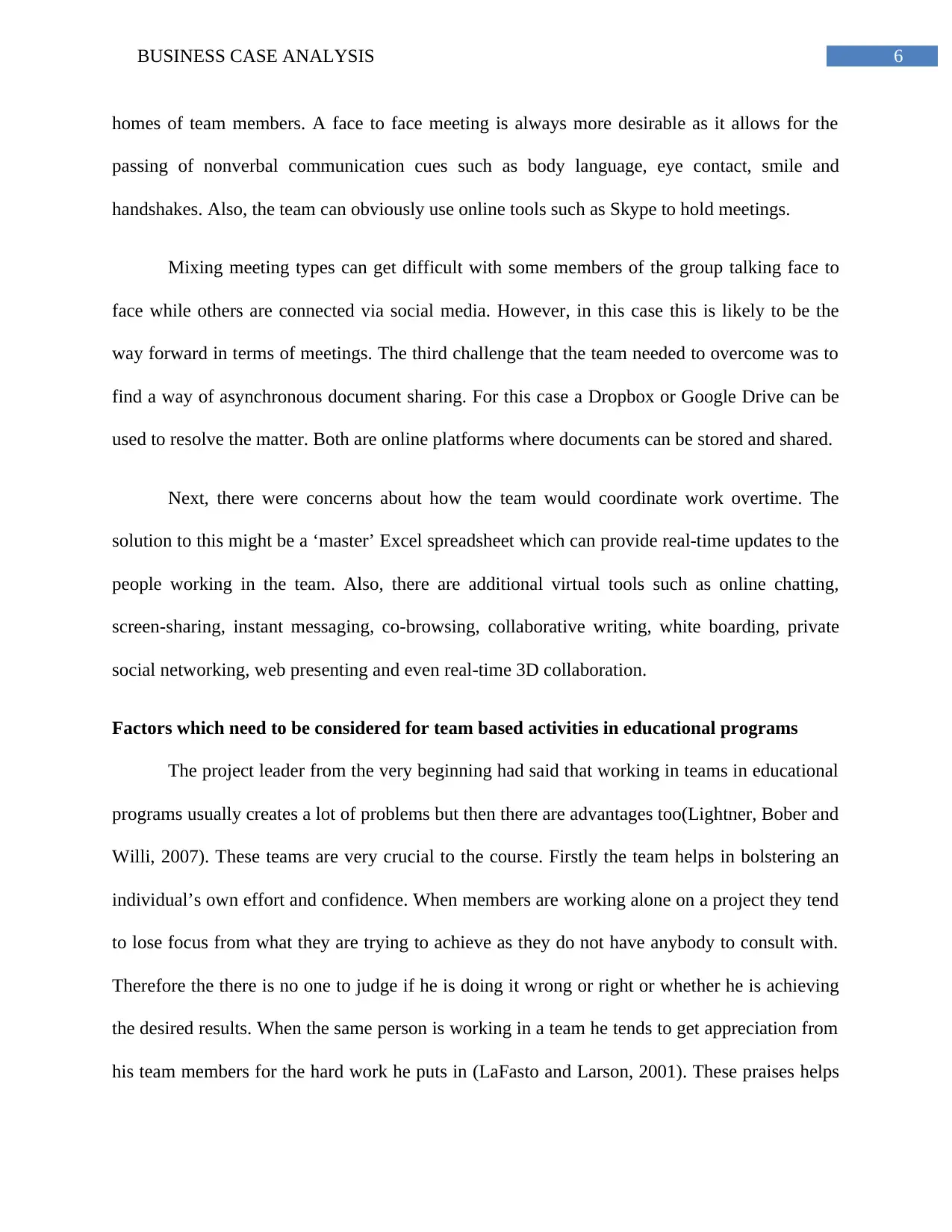
6BUSINESS CASE ANALYSIS
homes of team members. A face to face meeting is always more desirable as it allows for the
passing of nonverbal communication cues such as body language, eye contact, smile and
handshakes. Also, the team can obviously use online tools such as Skype to hold meetings.
Mixing meeting types can get difficult with some members of the group talking face to
face while others are connected via social media. However, in this case this is likely to be the
way forward in terms of meetings. The third challenge that the team needed to overcome was to
find a way of asynchronous document sharing. For this case a Dropbox or Google Drive can be
used to resolve the matter. Both are online platforms where documents can be stored and shared.
Next, there were concerns about how the team would coordinate work overtime. The
solution to this might be a ‘master’ Excel spreadsheet which can provide real-time updates to the
people working in the team. Also, there are additional virtual tools such as online chatting,
screen-sharing, instant messaging, co-browsing, collaborative writing, white boarding, private
social networking, web presenting and even real-time 3D collaboration.
Factors which need to be considered for team based activities in educational programs
The project leader from the very beginning had said that working in teams in educational
programs usually creates a lot of problems but then there are advantages too(Lightner, Bober and
Willi, 2007). These teams are very crucial to the course. Firstly the team helps in bolstering an
individual’s own effort and confidence. When members are working alone on a project they tend
to lose focus from what they are trying to achieve as they do not have anybody to consult with.
Therefore the there is no one to judge if he is doing it wrong or right or whether he is achieving
the desired results. When the same person is working in a team he tends to get appreciation from
his team members for the hard work he puts in (LaFasto and Larson, 2001). These praises helps
homes of team members. A face to face meeting is always more desirable as it allows for the
passing of nonverbal communication cues such as body language, eye contact, smile and
handshakes. Also, the team can obviously use online tools such as Skype to hold meetings.
Mixing meeting types can get difficult with some members of the group talking face to
face while others are connected via social media. However, in this case this is likely to be the
way forward in terms of meetings. The third challenge that the team needed to overcome was to
find a way of asynchronous document sharing. For this case a Dropbox or Google Drive can be
used to resolve the matter. Both are online platforms where documents can be stored and shared.
Next, there were concerns about how the team would coordinate work overtime. The
solution to this might be a ‘master’ Excel spreadsheet which can provide real-time updates to the
people working in the team. Also, there are additional virtual tools such as online chatting,
screen-sharing, instant messaging, co-browsing, collaborative writing, white boarding, private
social networking, web presenting and even real-time 3D collaboration.
Factors which need to be considered for team based activities in educational programs
The project leader from the very beginning had said that working in teams in educational
programs usually creates a lot of problems but then there are advantages too(Lightner, Bober and
Willi, 2007). These teams are very crucial to the course. Firstly the team helps in bolstering an
individual’s own effort and confidence. When members are working alone on a project they tend
to lose focus from what they are trying to achieve as they do not have anybody to consult with.
Therefore the there is no one to judge if he is doing it wrong or right or whether he is achieving
the desired results. When the same person is working in a team he tends to get appreciation from
his team members for the hard work he puts in (LaFasto and Larson, 2001). These praises helps
Paraphrase This Document
Need a fresh take? Get an instant paraphrase of this document with our AI Paraphraser
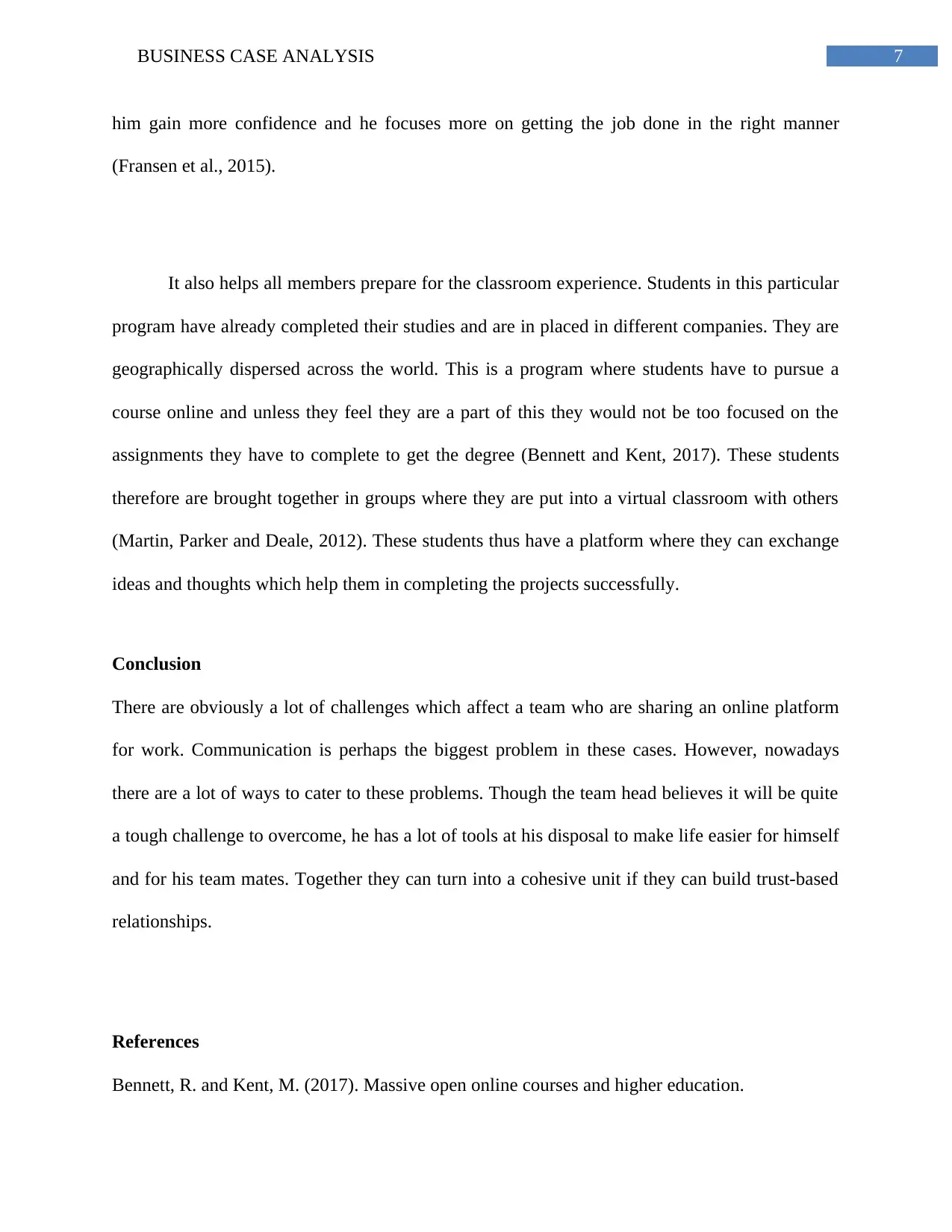
7BUSINESS CASE ANALYSIS
him gain more confidence and he focuses more on getting the job done in the right manner
(Fransen et al., 2015).
It also helps all members prepare for the classroom experience. Students in this particular
program have already completed their studies and are in placed in different companies. They are
geographically dispersed across the world. This is a program where students have to pursue a
course online and unless they feel they are a part of this they would not be too focused on the
assignments they have to complete to get the degree (Bennett and Kent, 2017). These students
therefore are brought together in groups where they are put into a virtual classroom with others
(Martin, Parker and Deale, 2012). These students thus have a platform where they can exchange
ideas and thoughts which help them in completing the projects successfully.
Conclusion
There are obviously a lot of challenges which affect a team who are sharing an online platform
for work. Communication is perhaps the biggest problem in these cases. However, nowadays
there are a lot of ways to cater to these problems. Though the team head believes it will be quite
a tough challenge to overcome, he has a lot of tools at his disposal to make life easier for himself
and for his team mates. Together they can turn into a cohesive unit if they can build trust-based
relationships.
References
Bennett, R. and Kent, M. (2017). Massive open online courses and higher education.
him gain more confidence and he focuses more on getting the job done in the right manner
(Fransen et al., 2015).
It also helps all members prepare for the classroom experience. Students in this particular
program have already completed their studies and are in placed in different companies. They are
geographically dispersed across the world. This is a program where students have to pursue a
course online and unless they feel they are a part of this they would not be too focused on the
assignments they have to complete to get the degree (Bennett and Kent, 2017). These students
therefore are brought together in groups where they are put into a virtual classroom with others
(Martin, Parker and Deale, 2012). These students thus have a platform where they can exchange
ideas and thoughts which help them in completing the projects successfully.
Conclusion
There are obviously a lot of challenges which affect a team who are sharing an online platform
for work. Communication is perhaps the biggest problem in these cases. However, nowadays
there are a lot of ways to cater to these problems. Though the team head believes it will be quite
a tough challenge to overcome, he has a lot of tools at his disposal to make life easier for himself
and for his team mates. Together they can turn into a cohesive unit if they can build trust-based
relationships.
References
Bennett, R. and Kent, M. (2017). Massive open online courses and higher education.
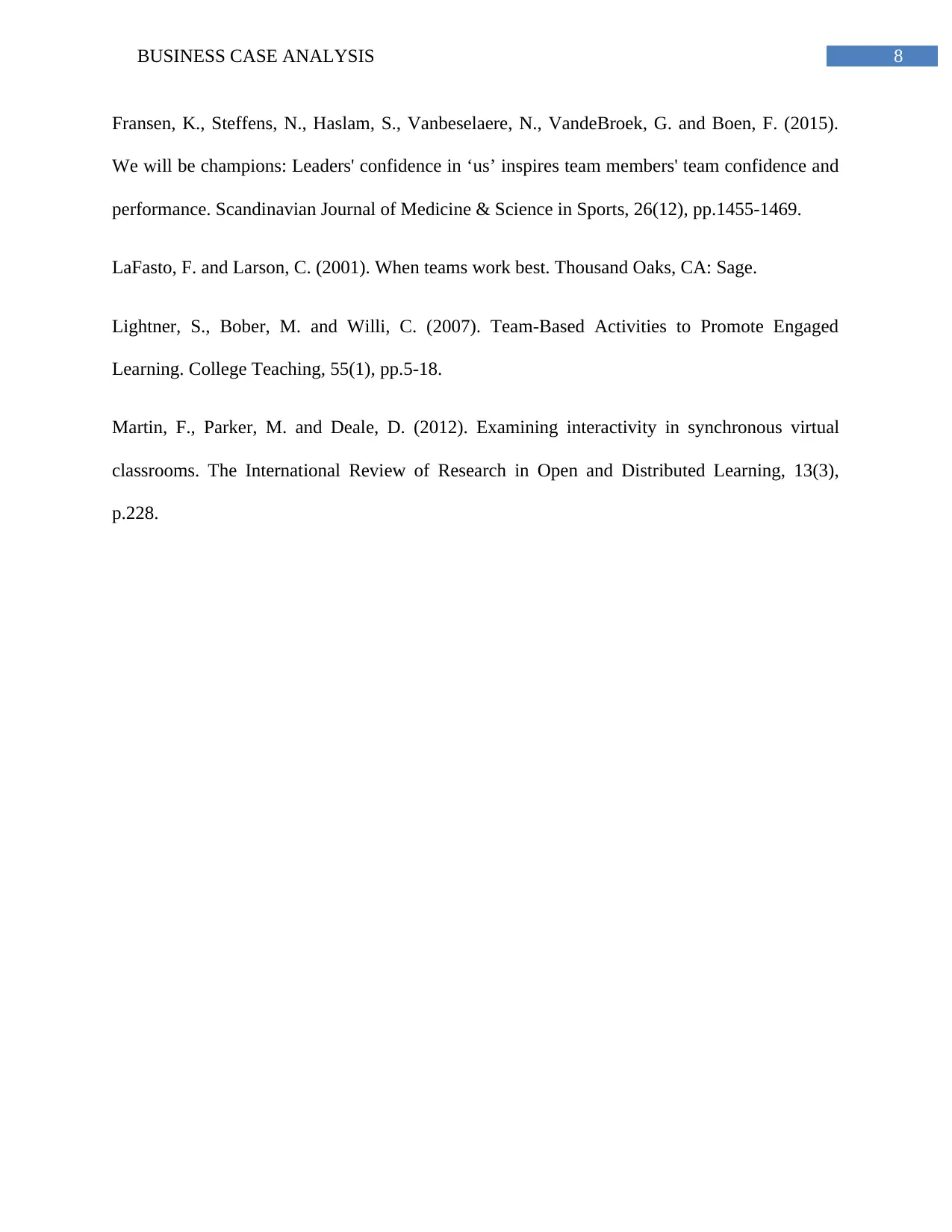
8BUSINESS CASE ANALYSIS
Fransen, K., Steffens, N., Haslam, S., Vanbeselaere, N., VandeBroek, G. and Boen, F. (2015).
We will be champions: Leaders' confidence in ‘us’ inspires team members' team confidence and
performance. Scandinavian Journal of Medicine & Science in Sports, 26(12), pp.1455-1469.
LaFasto, F. and Larson, C. (2001). When teams work best. Thousand Oaks, CA: Sage.
Lightner, S., Bober, M. and Willi, C. (2007). Team-Based Activities to Promote Engaged
Learning. College Teaching, 55(1), pp.5-18.
Martin, F., Parker, M. and Deale, D. (2012). Examining interactivity in synchronous virtual
classrooms. The International Review of Research in Open and Distributed Learning, 13(3),
p.228.
Fransen, K., Steffens, N., Haslam, S., Vanbeselaere, N., VandeBroek, G. and Boen, F. (2015).
We will be champions: Leaders' confidence in ‘us’ inspires team members' team confidence and
performance. Scandinavian Journal of Medicine & Science in Sports, 26(12), pp.1455-1469.
LaFasto, F. and Larson, C. (2001). When teams work best. Thousand Oaks, CA: Sage.
Lightner, S., Bober, M. and Willi, C. (2007). Team-Based Activities to Promote Engaged
Learning. College Teaching, 55(1), pp.5-18.
Martin, F., Parker, M. and Deale, D. (2012). Examining interactivity in synchronous virtual
classrooms. The International Review of Research in Open and Distributed Learning, 13(3),
p.228.
⊘ This is a preview!⊘
Do you want full access?
Subscribe today to unlock all pages.

Trusted by 1+ million students worldwide
1 out of 9
Related Documents
Your All-in-One AI-Powered Toolkit for Academic Success.
+13062052269
info@desklib.com
Available 24*7 on WhatsApp / Email
![[object Object]](/_next/static/media/star-bottom.7253800d.svg)
Unlock your academic potential
Copyright © 2020–2025 A2Z Services. All Rights Reserved. Developed and managed by ZUCOL.




